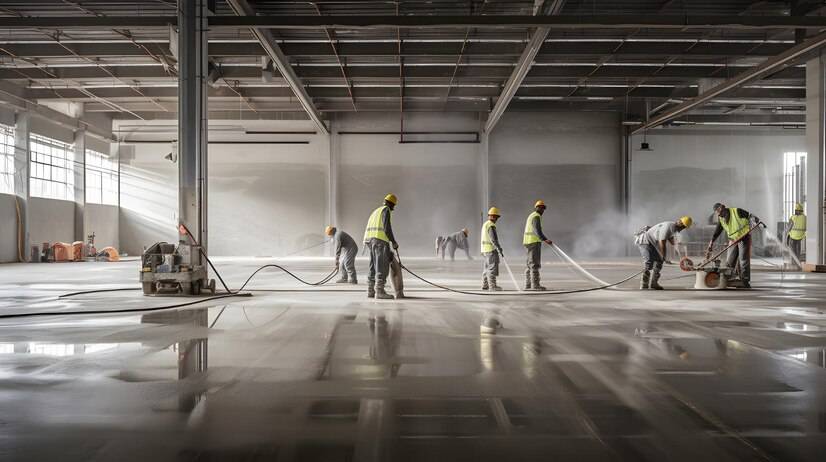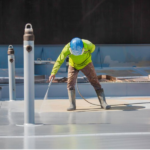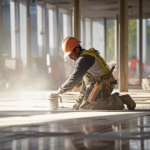In the realm of interior design, concrete flooring has evolved from a utilitarian choice to a chic and versatile option, offering both durability and aesthetic appeal. Whether for residential, commercial, or industrial spaces, concrete flooring stands out for its strength, longevity, and customizable design possibilities. As we delve into 2024, the options for concrete flooring continue to expand, offering an array of choices to suit diverse preferences and needs.
Factors to Consider When Choosing Concrete Flooring:
Before diving into the different types of concrete flooring, it’s important to consider a few key factors.
1.Durability: Concrete flooring is renowned for its robustness, but factors like foot traffic and potential chemical exposure must be taken into account.
2.Design Flexibility: Concrete can be polished, stained, stamped, or overlayed, allowing for various aesthetic effects.
3.Climate Suitability: Consideration of temperature fluctuations and moisture levels is crucial, especially for outdoor or basement installations.
4.Maintenance Requirements: Different finishes and coatings entail varying levels of upkeep.
5.Budget: Costs can vary depending on the type of concrete, finishes, and installation complexity.
Different Types of Concrete Flooring:
Now that you have considered the important factors, let’s explore the different types of concrete flooring available in the market.
1.Polished Concrete:
Achieving a glossy finish through grinding and polishing, this type enhances light reflection and can be customized with decorative elements.
2.Stained Concrete:
By applying acid or water-based stains, stained concrete offers a palette of hues while retaining the natural texture of the surface.
3.Stamped Concrete:
Mimicking the appearance of natural materials like stone or wood, stamped concrete adds visual interest and texture.
4.Epoxy Flooring:
Comprising epoxy resin and hardeners, this seamless and durable option is ideal for industrial and commercial settings.
5.Microtopping:
A thin layer of cement-based compound applied over existing concrete, microtopping rejuvenates worn surfaces with a smooth, contemporary look.
Pros and Cons of Each Type of Concrete Flooring:
To help you make an informed decision, let’s discuss the pros and cons of each type of concrete flooring.
1. Polished Concrete:
Polished concrete is achieved by grinding and polishing the surface to create a glossy finish. It enhances light reflection and can be customized with decorative elements.
Pros:
1. Durability: Polished concrete is exceptionally durable, able to withstand heavy foot traffic and resist abrasion, making it ideal for high-traffic areas like retail spaces and warehouses.
2. Low Maintenance: With its smooth surface, polished concrete is easy to clean and requires minimal maintenance. Regular sweeping and occasional damp mopping are usually sufficient to keep it looking pristine.
Cons:
1. Susceptible to Stains: Despite its durability, polished concrete is porous and can be susceptible to stains from spills if not sealed properly. Certain acidic substances, like vinegar or citrus juices, can etch the surface if not cleaned promptly.
2. Professional Installation Required: Achieving a high-quality polished concrete finish requires specialized equipment and expertise. Improper installation can result in uneven polishing or a lackluster appearance, necessitating professional assistance.
2. Stained Concrete:
Stained concrete involves applying acid or water-based stains to the surface to introduce color while retaining the natural texture of the concrete.
Pros:
1. Versatile Aesthetic: Stained concrete offers a wide range of colors and finishes, allowing for customization to suit various design preferences and styles. It can mimic the look of natural stone, wood, or even metallic surfaces.
2. Long-Lasting Color: Unlike surface coatings or paints, stains penetrate the concrete, resulting in color that won’t fade or peel over time. With proper maintenance and periodic resealing, stained concrete can retain its vibrant hue for years.
Cons:
1. Periodic Resealing Required: While stained concrete is generally low maintenance, it does require periodic resealing to protect the surface and maintain its appearance. The frequency of resealing depends on factors such as foot traffic and exposure to UV light.
2. Limited to Existing Surface: Stains react differently to each concrete surface, meaning the final color and appearance can vary depending on the substrate. Additionally, surface imperfections or blemishes may still be visible after staining, as it does not hide them completely.
3.Stamped Concrete:
Stamped concrete mimics the appearance of natural materials like stone, brick, or wood by imprinting patterns onto the surface.
Pros:
1.Versatile Design Options: Stamped concrete can mimic the look of various materials such as brick, stone, or wood, providing versatility in design and allowing for the creation of custom patterns and textures.
2.Adds Visual Interest: The textured surface of stamped concrete adds visual interest and dimension to outdoor spaces like patios and walkways, enhancing curb appeal.
Cons:
1.Maintenance Challenges: Intricate patterns and textures of stamped concrete can make maintenance more challenging, requiring periodic resealing and potential repairs to preserve the appearance.
2.Costly Installation: While stamped concrete offers aesthetic benefits, the installation process can be labor-intensive and costly, particularly for complex designs or large areas.
4.Epoxy Flooring:
Epoxy flooring consists of epoxy resin and hardeners applied over concrete surfaces to create a seamless, durable, and chemically resistant finish.
Pros:
1.Chemical Resistance: Epoxy flooring is highly resistant to chemicals, making it ideal for industrial settings where exposure to harsh substances is common.
2.Seamless and Hygienic: Its seamless surface inhibits the growth of bacteria and mold, making epoxy flooring easy to clean and maintain in environments requiring strict hygiene standards.
Cons:
1.Maintenance Challenges: Intricate patterns and textures of stamped concrete can make maintenance more challenging, requiring periodic resealing and potential repairs to preserve the appearance.
2.Costly Installation: While stamped concrete offers aesthetic benefits, the installation process can be labor-intensive and costly, particularly for complex designs or large areas.






